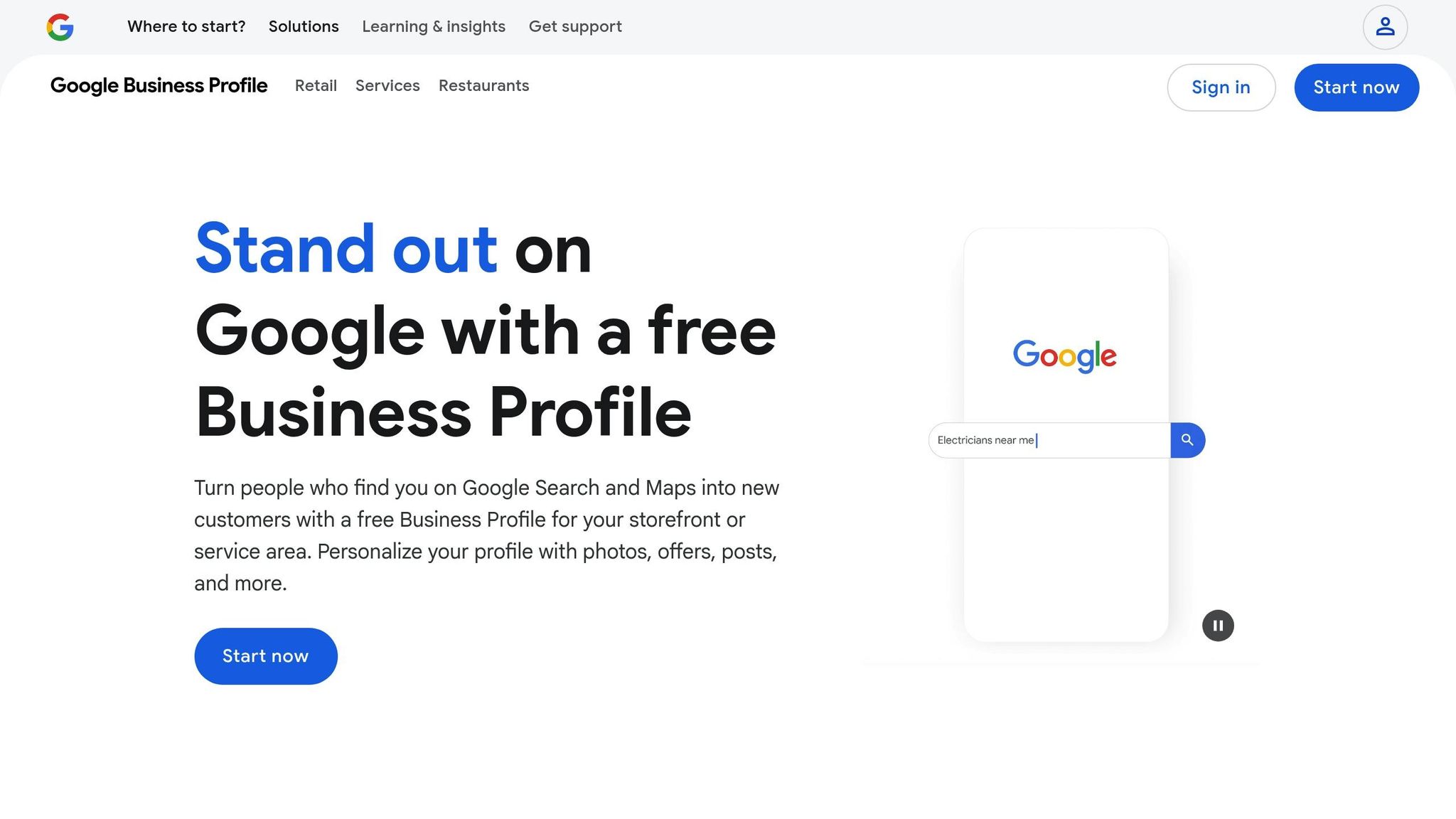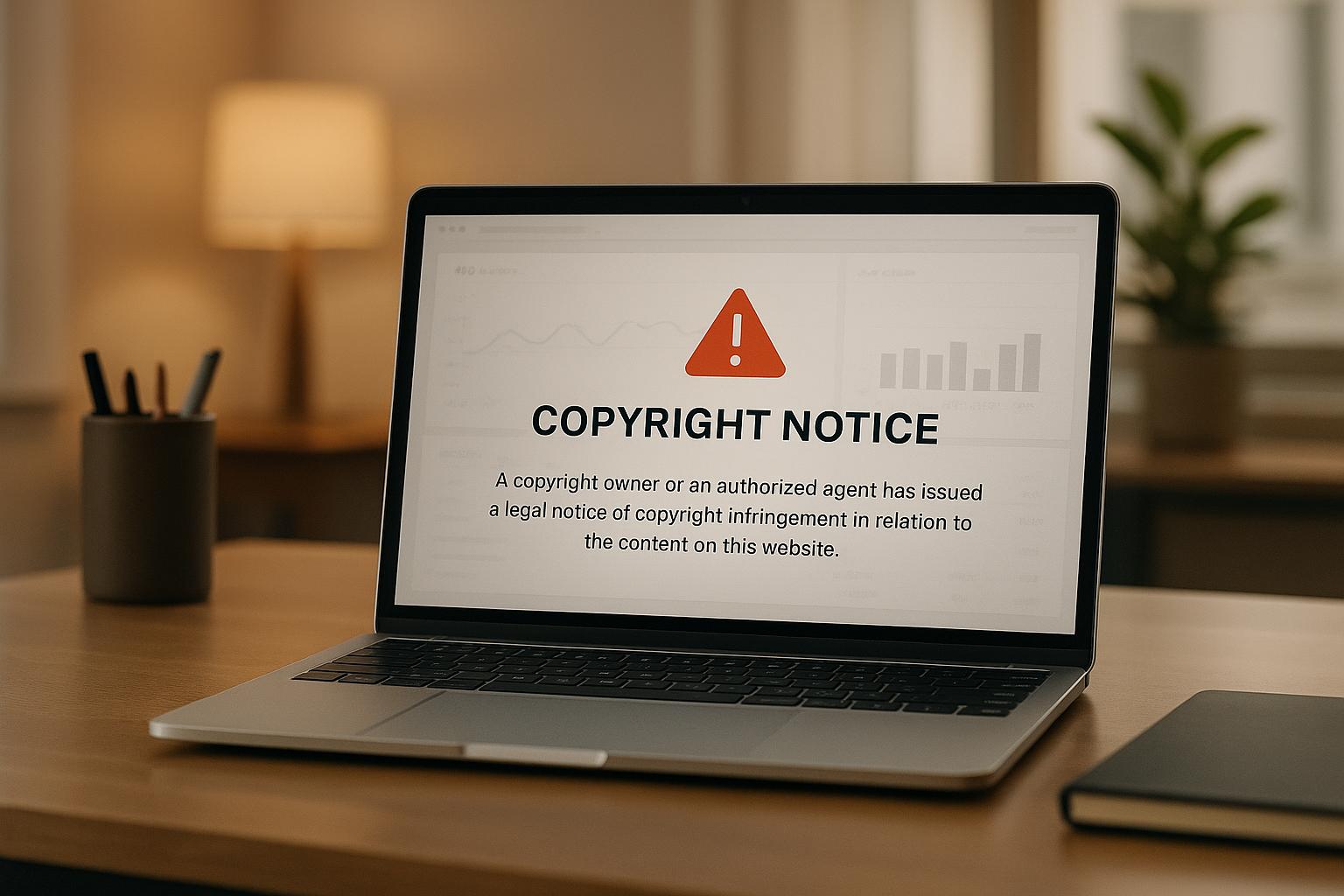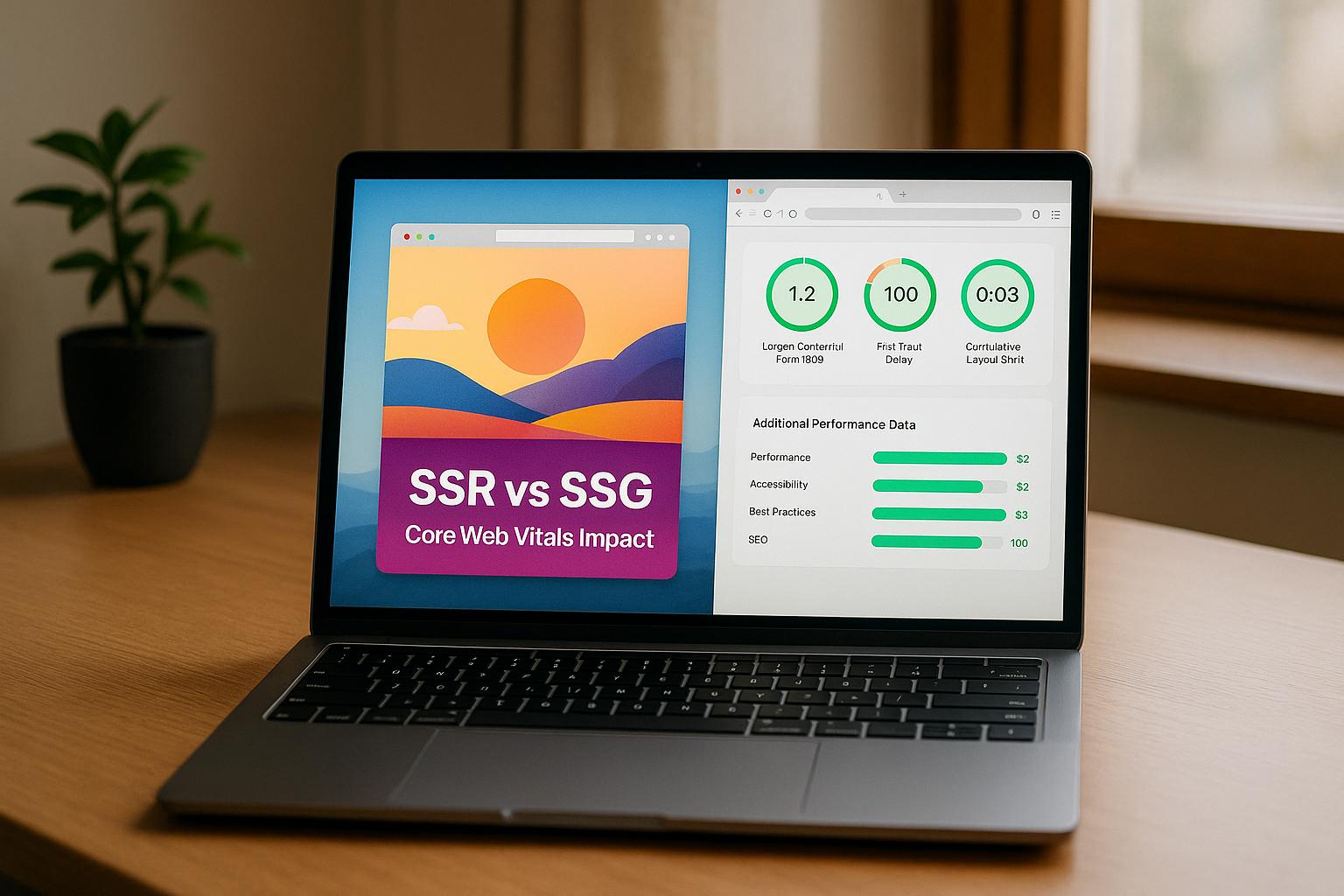When users search for terms like "pizza near me" or "dentist in Chicago", the Local Pack - a map with three business listings - often appears at the top of Google results. This is prime visibility for local businesses, but standing out requires more than luck. Optimizing your Click-Through Rate (CTR) in the Local Pack can directly boost traffic, calls, and customer actions. Here’s what you need to know:
- Why CTR Matters: The top Local Pack position gets over 30% of clicks, with sharp declines for lower spots. CTR also signals Google that your listing is relevant, improving rankings.
- How to Optimize:
- Fully update your Google Business Profile (accurate NAP details, photos, business hours, and localized descriptions).
- Use high-quality visuals (photos, videos, and even virtual tours) to grab attention.
- Encourage customer reviews and respond thoughtfully to build trust.
- Track performance using tools like Google Business Profile Insights and UTM codes.
- Key Metrics to Watch: Website clicks, phone calls, direction requests, and bookings.
Google Business Profile Optimization Best Practices for Ranking on Google Maps

Setting Up Your Business for Local Pack Success
Your Google Business Profile is the foundation of your local search presence, and its importance can’t be overstated. Every detail plays a role in securing one of those top three Local Pack spots.
Optimizing Your Google Business Profile
To stand out in the Local Pack, your Google Business Profile needs to be complete, accurate, and visually appealing. Start by ensuring your NAP (Name, Address, Phone) is formatted consistently - stick to USPS standards like ‘123 Main St, City, ST, ZIP’ and use a clear phone format such as (555) 123-4567 or 555-123-4567.
High-quality images are a must. Use well-lit, professional photos that highlight your storefront, interior, team, and products. Including recognizable local landmarks in your images can also boost relevance. These visuals help customers identify your location while building trust and credibility.
Choose a specific primary category for your business and write a concise, localized description packed with neighborhood-specific keywords. Include clear business hours using the 12-hour AM/PM format, and don’t forget to add special hours for holidays like Thanksgiving or the Fourth of July. A keyword-rich business description that addresses local customer needs can also make your listing more appealing in Local Pack results.
Take advantage of attributes to showcase what makes your business stand out. Highlight features like "wheelchair accessible", "free Wi-Fi", or "outdoor seating" to attract the right audience. If your business involves measurements - like construction or landscaping - use imperial units (feet, miles, inches) to align with U.S. standards.
Once your profile is polished, shift your focus to managing customer reviews, which play a big role in boosting your Local Pack rankings.
Managing Customer Reviews
Customer reviews are key to improving your Local Pack rankings and click-through rates. Google increasingly values user engagement, and reviews send strong signals of trust and relevance.
To encourage new reviews, make it easy for customers to share their feedback. Invite them to leave reviews at the point of sale, follow up with emails linking directly to your Google Business Profile review section, and keep the process simple. The number, quality, and recency of reviews all contribute to better rankings, so a steady stream of fresh reviews is essential.
Responding to every review - both positive and negative - shows you care about customer satisfaction. Personalize your responses, addressing specific points mentioned in the reviews. For negative feedback, acknowledge the issue, apologize if necessary, and offer to resolve the problem offline. This not only helps rebuild trust with unhappy customers but also shows potential clients that you’re responsive and committed to quality service.
A strong review profile, complete with a high star rating, can make your business stand out at a glance. That visual rating in the Local Pack is often the first thing customers notice, and it can strongly influence their decision to click.
In addition to reviews, keeping your business information accurate is critical for maintaining search credibility.
Keeping Business Information Accurate
Consistency in your NAP details across all directories is crucial for accurate citation matching. Search engines rely on this consistency to verify your business’s legitimacy. Audit your listings monthly and update any changes promptly. Even small inconsistencies, like switching between ‘Ave’ and ‘Avenue,’ can confuse search engines and hurt your rankings. If you relocate or change your phone number, update every listing at the same time to avoid losing visibility.
Beyond NAP details, clearly define your service areas by listing well-known city names and ZIP codes. Adding price range indicators (e.g., $ to $$$) helps manage customer expectations, and using the "from the business" section allows you to highlight what makes your business special.
To track your Local Pack performance, implement UTM tracking in your profile URL. This will help you monitor traffic and measure the impact of your Local Pack efforts.
For added support, explore resources like the Top SEO Marketing Directory. These tools can simplify citation management, monitor your reputation, and streamline your local SEO efforts, making it easier to maintain a strong presence in the Local Pack.
Key Strategies to Improve Local Pack CTR
Once your Google Business Profile is fully optimized, the next step is to focus on strategies that drive clicks. With only three businesses displayed in the Local Pack, standing out means carefully refining every visual and textual element to grab attention.
Improving Visual Appeal
Visuals are often the first thing potential customers notice, and they play a big role in whether someone clicks on your business. High-quality images and videos can make your listing more engaging and appealing, increasing the chances of attracting clicks.
Professional photography is a game-changer. Upload clear, well-lit photos that showcase your storefront, highlight your products or services, and feature your team in action. For example, a restaurant might include photos of mouthwatering dishes, a clean dining area, and friendly staff. Service-based businesses, like plumbers or contractors, can add before-and-after shots to build trust.
Short videos can make your listing stand out even more. These could include a mechanic explaining a repair process, a virtual tour of a dental office, or a retail store showcasing new arrivals. Videos give potential customers a better sense of what they can expect.
Keep your visual content fresh by updating it regularly. Highlight seasonal themes, current inventory, or special events. For instance, a landscaping company might upload photos of spring plantings or snow removal equipment during winter. This signals that your business is active and relevant.
Optimize images for mobile devices, as most local searches happen on smartphones. Make sure photos load quickly and display well on smaller screens; slow-loading visuals can hurt your click-through rates.
If your business benefits from showcasing interiors, consider adding virtual tours or 360-degree photos. Hotels, restaurants, retail stores, and medical offices can use these to give potential customers a complete view of the space before they visit.
Highlighting Your Selling Points
Every word in your Local Pack listing matters. Use this space to communicate the unique benefits of your business and address local customer needs.
Utilize the "From the Business" section to emphasize specific advantages. Avoid generic descriptions and focus on what makes you stand out, like "Same-day service available" or "Free estimates within 24 hours." For instance, a law firm might highlight "Free case reviews", while a home repair service could stress "15+ years of licensed local experience."
Include attributes that set you apart, such as "wheelchair accessible", "free Wi-Fi", "accepts credit cards", or "veteran-owned." These small details can make a big difference when customers are comparing businesses.
Write tailored descriptions that address local concerns. For example, a dentist in Austin could say, "Family dentist serving South Austin since 2010", which speaks directly to the community and boosts local relevance.
Promote time-sensitive offers and seasonal deals. Highlight promotions like "10% off first-time customers through December" or "Free delivery on orders over $50" to give customers an immediate reason to choose your business.
Showcase unique qualifications such as certifications, awards, or years of experience. Details like "Better Business Bureau A+ rating" or "EPA-certified lead removal specialist" can help build trust and differentiate your business.
Address common customer concerns directly in your messaging. If pricing is a frequent worry, use phrases like "transparent pricing" or "no hidden fees." For service-based businesses, mentioning "fully licensed and insured" can reassure potential customers.
Once your key selling points are clear, use performance data to refine and improve your messaging further.
Using Data and Testing for Optimization
After enhancing your visuals and messaging, track the results to ensure continuous improvement. Google Business Profile Insights offers valuable metrics like website clicks, phone calls, and direction requests, giving you a clear picture of how your listing is performing.
Focus on the right metrics to determine which parts of your listing are driving results. Use UTM tracking with Google Analytics to connect your Local Pack performance to broader business outcomes. This helps you understand the real value of your visibility.
Test different visuals and descriptions to find what works best. For instance, try rotating your primary image - like a storefront photo versus a product shot - and track which gets more engagement. A fitness center might test "24/7 gym access" against "personal training included" to see which message resonates more. Keep records of these tests to guide future updates.
Evaluate competitor performance by searching for your target keywords and analyzing which businesses in the Local Pack generate the most engagement. Look at their images, descriptions, and attributes to identify opportunities to stand out.
Segment your audience using Google Analytics to see which groups are engaging most with your listing. Tailor your visuals and messaging to attract those customers more effectively.
Regularly review performance and adjust based on trends. If new photos lead to more direction requests, keep refreshing your visuals. Similarly, if emphasizing certain services increases phone calls, make those features more prominent.
For businesses looking to dive deeper into analytics, the Top SEO Marketing Directory provides tools and resources specifically designed for tracking Local Pack performance and conducting A/B tests.
sbb-itb-5be333f
Measuring and Tracking Local Pack CTR Performance
Once you've implemented your optimization strategies, the next step is keeping tabs on how well they're working. Tracking performance isn't just helpful - it's essential. Without it, you're essentially guessing at what’s effective and what isn’t when it comes to your Local Pack visibility.
Key Metrics to Track
Google Business Profile Insights is your go-to tool for understanding how users interact with your listing. Pay close attention to five core metrics that can directly influence your business: website clicks, phone calls, driving direction requests, profile views, and bookings.
- Website Clicks: These show how well your listing directs traffic to your site. A sudden dip in clicks could mean competitors have updated their profiles or that your content needs a refresh.
- Phone Calls: For service-based businesses like restaurants, contractors, or medical offices, this metric is gold. Track not just the volume but also the timing of calls to identify peak inquiry hours and adjust staffing accordingly.
- Direction Requests: These are an indicator of strong intent to visit your location. If you see a high number of requests but low foot traffic, it might point to issues like poor accessibility or unclear signage.
- Profile Views: Think of these as your visibility metric. While they don’t directly translate to sales, they give you a sense of how often your business is appearing in search results.
- Bookings: If your business offers reservations or appointments, this metric is a direct link to revenue and should be closely monitored.
Additionally, track secondary actions like photo views, post engagement, or menu clicks (if applicable). These metrics can reveal which aspects of your profile resonate most with potential customers and where you might need to make adjustments.
Analyzing Data for Insights
Numbers alone don’t tell the full story - it’s the patterns behind them that matter. With your data in hand, dive deeper to uncover trends and actionable insights.
Use UTM tracking codes to link Local Pack interactions to website behavior. Segment your data to identify trends by day, time, or even season. For instance, a landscaping company might notice a spike in direction requests on weekends, while a B2B service could see more activity during weekday business hours.
Rather than stressing over daily fluctuations, focus on month-over-month comparisons. Local search trends can shift due to factors like weather, seasonal events, or local happenings. A three-month rolling average can give you a clearer picture of your performance over time.
Correlate your Local Pack metrics with sales data. If you’re seeing more profile views and clicks but no increase in sales, it’s time to dig deeper. Issues like a clunky website, unclear pricing, or poor customer experience could be holding you back.
Keep an eye on your competitors, too. Regularly search for your target keywords and observe any changes in the Local Pack results. If a competitor starts outperforming you, analyze what they’ve recently updated - new photos, reviews, or other profile tweaks - and consider how you can apply similar strategies.
Continuous Improvement Through Data
Once you've analyzed your metrics, use the findings to refine your approach. Local Pack optimization isn’t a one-and-done task; it requires ongoing adjustments to stay effective. Review your metrics monthly to spot opportunities for improvement.
Make changes incrementally and track their impact. For instance, use Google Analytics to observe how Local Pack visitors behave on your site compared to other traffic sources. This can help you understand what’s working and what isn’t.
If you notice a decline in performance, act quickly. Check for competitor updates, recent reviews, or potential website issues. The faster you address problems, the less damage they’ll do to your results.
Document your changes and their outcomes. Keeping a record of what you’ve tried, when you tried it, and what happened can guide future decisions. Over time, this historical data becomes a valuable resource for understanding what strategies perform best for your business.
For those looking to step up their analytics game, tools from resources like the Top SEO Marketing Directory can help you track Local Pack performance and dive deeper into local search metrics.
Finally, focus on the metrics that align with your business goals. A restaurant might prioritize driving direction requests and phone calls, while a local e-commerce store might zero in on website clicks and online orders. Tailor your tracking to what truly matters for your business, rather than trying to optimize every single metric.
Advanced Tactics and Resources for Long-Term CTR Growth
Sustaining a strong Local Pack CTR isn’t a one-time effort - it’s an ongoing process. The digital landscape evolves quickly, and strategies that worked six months ago might not deliver the same results today. Staying ahead requires a mix of adaptability and strategic thinking.
Staying Current with SEO Trends
Google’s algorithm updates can dramatically change how Local Pack results are displayed and ranked. The search engine increasingly factors in user engagement signals like CTR, bounce rate, and dwell time when determining local rankings. Ignoring these updates could lead to a sudden drop in visibility.
For instance, one local service business boosted their Local Pack CTR by 35% over a year by consistently updating their Google Business Profile with seasonal photos, responding promptly to reviews, and adjusting their strategy based on algorithm changes. They refined their business descriptions to include trending local keywords, which helped them maintain top positions in the Local Pack.
The impact of algorithm updates is clear: businesses that adapt quickly often see measurable improvements in CTR. The top spot in the Google Map Pack garners an average CTR of 17.6%, while the second and third positions drop to 15.4% and 15.1%, respectively. Beyond these positions, CTR drops significantly, making it critical to stay competitive through continuous optimization.
| Local Pack Position | Average CTR (%) |
|---|---|
| 1 | 17.6 |
| 2 | 15.4 |
| 3 | 15.1 |
Technical performance also plays a big role in CTR. Nearly half of US consumers expect web pages to load within 2 seconds, and slower pages can experience bounce rates as high as 38%. Addressing these technical factors is essential for keeping users engaged.
To stay informed, consider subscribing to reputable SEO news outlets, joining industry forums, and setting up Google Alerts for local SEO updates. These resources can help you catch potential issues early and fine-tune your strategies before they impact your CTR.
Using Expert Resources
Advanced tools and professional insights are key to driving consistent Local Pack CTR growth. While managing a Google Business Profile is a good starting point, achieving long-term success often requires specialized resources.
The Top SEO Marketing Directory is a valuable source for vetted SEO tools, agencies, and software providers that focus on local SEO. Instead of spending hours researching solutions, you can access a curated list of platforms offering services like in-depth audits, competitive analysis, and ongoing optimization strategies.
These expert resources allow businesses to implement advanced tactics, such as:
- Creating localized content tailored to neighborhood-specific queries
- Using structured data to improve listing visibility
- Leveraging analytics platforms for deeper insights and tracking opportunities
Professional agencies listed in the directory bring expertise in local search trends and can develop strategies tailored to your business model and market conditions. This level of specialization often leads to sustained CTR growth and a competitive edge that’s hard to achieve with a DIY approach.
Following US-Specific Conventions
Adhering to US-specific standards can enhance your local SEO efforts and improve CTR. American users expect certain formatting and cultural details, and meeting these expectations can build trust and increase engagement.
Here’s what to keep in mind:
- Prices: Always display with a dollar sign (e.g., $19.99).
- Dates: Use the MM/DD/YYYY format.
- Measurements: Use miles and feet for distances, and Fahrenheit for temperatures.
- Numbers: Follow US formatting with commas for thousands and periods for decimals (e.g., 1,234.56).
- Phone Numbers: Format as (XXX) XXX-XXXX.
Spelling conventions also matter. Use American spellings like "color" instead of "colour" and "optimize" instead of "optimise." Additionally, American consumers tend to prefer direct, benefit-focused messaging that highlights convenience and value. Including references to local landmarks, neighborhoods, or cultural touchpoints can make your business feel more relevant to location-specific searches.
Regularly auditing your business listings for consistency in formatting, spelling, and cultural relevance ensures your profile remains optimized. These small but impactful details can significantly enhance your CTR performance over time.
Conclusion and Key Takeaways
Optimizing for Local Pack Click-Through Rate (CTR) has become a must for businesses in the U.S. today. As Google increasingly weighs user engagement metrics like CTR, bounce rate, and dwell time in its rankings, ignoring these factors can leave businesses lagging behind their competition.
The strategies outlined here are effective because they focus on what truly matters to both search engines and your customers. Accurate business details build credibility, compelling visuals grab attention, and localized content resonates with your community. Pair these with consistent review management and technical fine-tuning, and you're likely to see real, measurable results.
Every part of your Local Pack listing impacts user engagement, making optimization a priority. For instance, the top position in the Local Pack garners the most clicks, so even small adjustments can make a big difference. Something as simple as fixing duplicate title tags, which can reduce CTR by up to 20%, can lead to quick wins.
Website speed is another critical factor. A page that loads in under 2 seconds is key to keeping users engaged, especially since nearly half of users expect this level of performance. Slow-loading pages can push bounce rates as high as 38%, a risk businesses can't afford to take.
Sustained success depends on tracking and refining your efforts. Use tools like Google Business Profile Insights to monitor key metrics, implement UTM codes to evaluate traffic quality, and adjust your strategies monthly based on the data you gather [2,5].
For businesses aiming to elevate their Local Pack performance, the Top SEO Marketing Directory provides a handpicked selection of SEO tools, agencies, and software tailored to local search. These resources offer analytics, technical audits, and strategic insights designed to meet the demands of your specific market.
FAQs
How can I use UTM codes to track the success of my Local Pack optimization efforts?
UTM codes offer a smart way to gauge how well your Local Pack optimization efforts are performing. By attaching UTM parameters to the URLs in your Google Business Profile, you can track traffic sources using tools like Google Analytics. This gives you a clear picture of which campaigns or strategies are bringing in the most clicks.
To set this up, craft UTM codes with parameters such as source (e.g., "Google"), medium (e.g., "organic"), and campaign (e.g., "local-pack-optimization"). Once you've created these tagged URLs, include them in your business listing. Over time, review the data in your analytics platform to uncover patterns and fine-tune your strategy for even better results.
What are the best advanced strategies to keep a high Click-Through Rate (CTR) in the Local Pack over time?
To keep your Click-Through Rate (CTR) high in the Local Pack, you'll need to go beyond the basics and dive into strategies like fine-tuning your Google Business Profile, managing reviews effectively, and using smart local SEO techniques.
Start by ensuring your Google Business Profile is complete and polished. Double-check that all business details are accurate - things like your address, phone number, and hours of operation. Add high-quality photos to showcase your business and keep your posts fresh and relevant. Encourage happy customers to leave reviews, and make it a habit to respond to them - this not only builds trust but also keeps your profile active and engaging. Don’t forget to weave localized keywords into your business description and any content you share to match what your audience is searching for.
To stay ahead, keep an eye on your performance metrics. Regularly analyze trends and adjust your approach, especially during seasonal shifts. You can also try geo-targeted ads and special promotions to draw in more local customers and give your business an edge in search results.
Why is it important to follow US-specific formatting in my Google Business Profile, and how does it affect my Local Pack ranking?
Using US-specific formatting in your Google Business Profile is key to connecting with local customers and boosting your performance in the Local Pack. Pay attention to details like the proper currency format ($), date and time format (MM/DD/YYYY and 12-hour clock), number format (commas for thousands, periods for decimals), imperial units (inches, feet, miles), and Fahrenheit for temperature. These small adjustments make your information clearer and more relevant for US users.
When your profile matches local norms, it not only improves the user experience but also signals to search engines that your business is tailored for the local market. This alignment can lead to better search visibility and higher click-through rates, helping you attract more potential customers.


